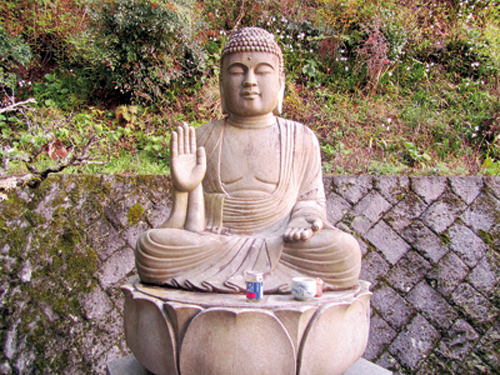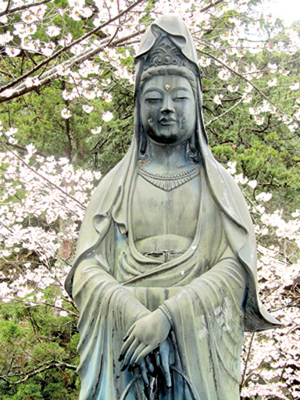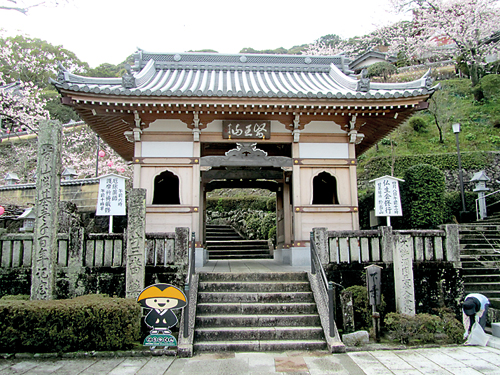Soaking in the pilgrim sites of Shikoku

Buddha Statue at Temple
A few years ago I decided to walk the 88 Temple Pilgrim Trail on Japan’s island of Shikoku.
My intention of undertaking this pilgrimage was not influenced by any particular religious calling nor even a desire to ask for a particular boon or even to atone for sins committed -reasons which I am told are the motivations behind many such pilgrimages! Perhaps I, like Ulysses of Ithaca, ‘cannot rest from travel’ and my decision to make this journey originated from a need to travel, to ‘follow knowledge like a sinking star’ and see for myself places and things about which I had read so much – and to experience a part of Japan that is hidden from most tourists visiting that country.
Shikoku is the smallest of Japan’s four major islands – tucked into the gulf called the Seto Inland Sea and connected to the largest island Honshu by two motorway carrying bridges. Relatively isolated from the big cities like Tokyo, Yokohama, Osaka and Nagoya, Shikoku has been described as being decades behind these huge modern metropolises. Japan itself is a land that has two seemingly incongruous ways of living: concrete and bustle and constant noise in the modern cities where one is incessantly exposed to an endless stream of stimuli that boggles one’s brain – versus quiet rural village life where one is surrounded by nature and tranquillity.

Memorable sights: The Katsuharama Beach
Walking the entire 120 kilometre trail around Shikoku and visiting each of the 88 temples can be done in one journey – but it would have taken me a minimum of three months to do so. Better I felt to accept my age and do this journey in stages, spending two to three weeks each time, walking as far as my legs would take me – and then returning a year later to pick up my journey from where I had left off.
Walking from temple to temple along the pilgrim trail one walks amidst tranquil countryside surrounded by mountains and seas- and visits hallowed places associated with the monk Kobo Daishi, founder of Japan’s Shingon Buddhist sect. One passes through places that live on in memory long after the journey is over – like picturesque Katsuharama beach and the cape of Ashizuri with its beautiful sunrises. Along the way one comes across so many sites where one can savour the beauty of Sakura cherry blossom trees in bloom.

Statue at Temple 23 Yakuo-ji
The purpose of the pilgrimage is to visit each of the 88 temples and pay one’s respects, perchance to pray or chant or meditate. But the purpose of this pilgrimage is also to walk – to appreciate the beauty of the countryside, to spend this time making the journey in the company of a loved one or just in the company of one’s thoughts.
Each time I return home to Sri Lanka I bring back memories of climbing sun dappled forest paths, winding my way through narrow village lanes and staying overnight in the simple homes (called Minshu-kus, a typically Japanese version of bed and breakfast homestays) of Shikoku people who I have found overwhelmingly kind and helpful. A typical minshuku is a warm, friendly and relatively inexpensive lodging where meals are taken in the communal dining room with family and other guests, giving one the opportunity of experiencing living the way Japanese people live.
And at the end of each hard day’s travel I relish the pleasure of that quintessentially Japanese custom of the hot bath, the Ofuro. The soreness of my muscles, tired after long hours of walking, soaks away in the warmth of the 40 degree waters of the Ofuro – and on some evenings if I am lucky even in an actual natural hot spring or Onsen. As the warmth of the water seeps into my body I experience a feeling of intense gratitude for accomplishing that day’s journey.
Chin-deep in the hot tub and at peace with the world I give thanks– to God, to the deities of Japan, to the monk Kobo Daishi who founded this pilgrimage, to the Great Architect of the Universe, to the Universe itself – for the very privilege of being alive and having the opportunity of being a pilgrim on Shikoku.

Entrance of Temple 23- Yakuo-ji


